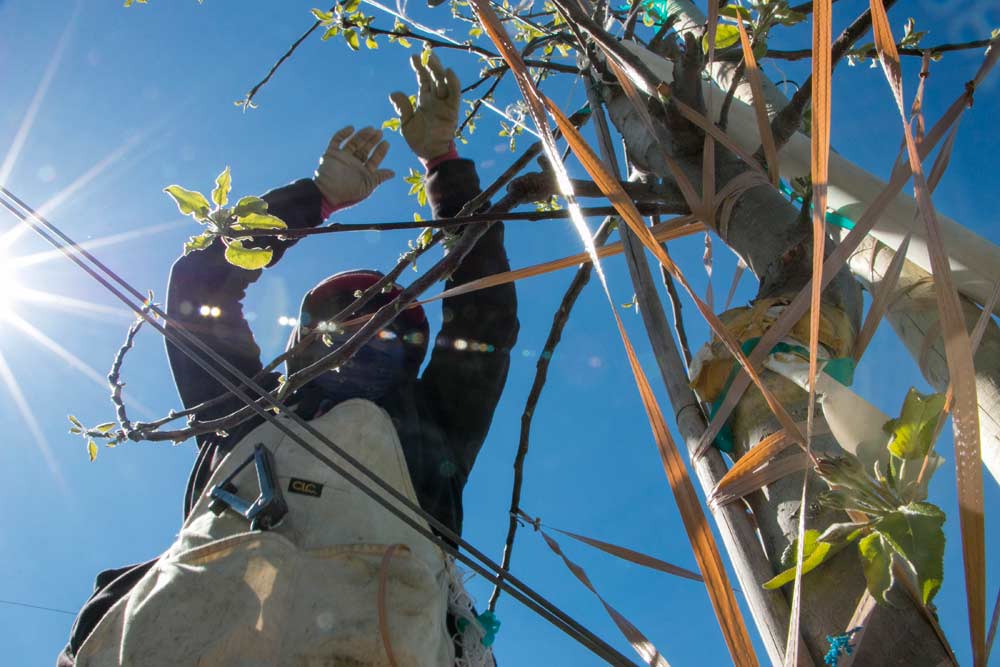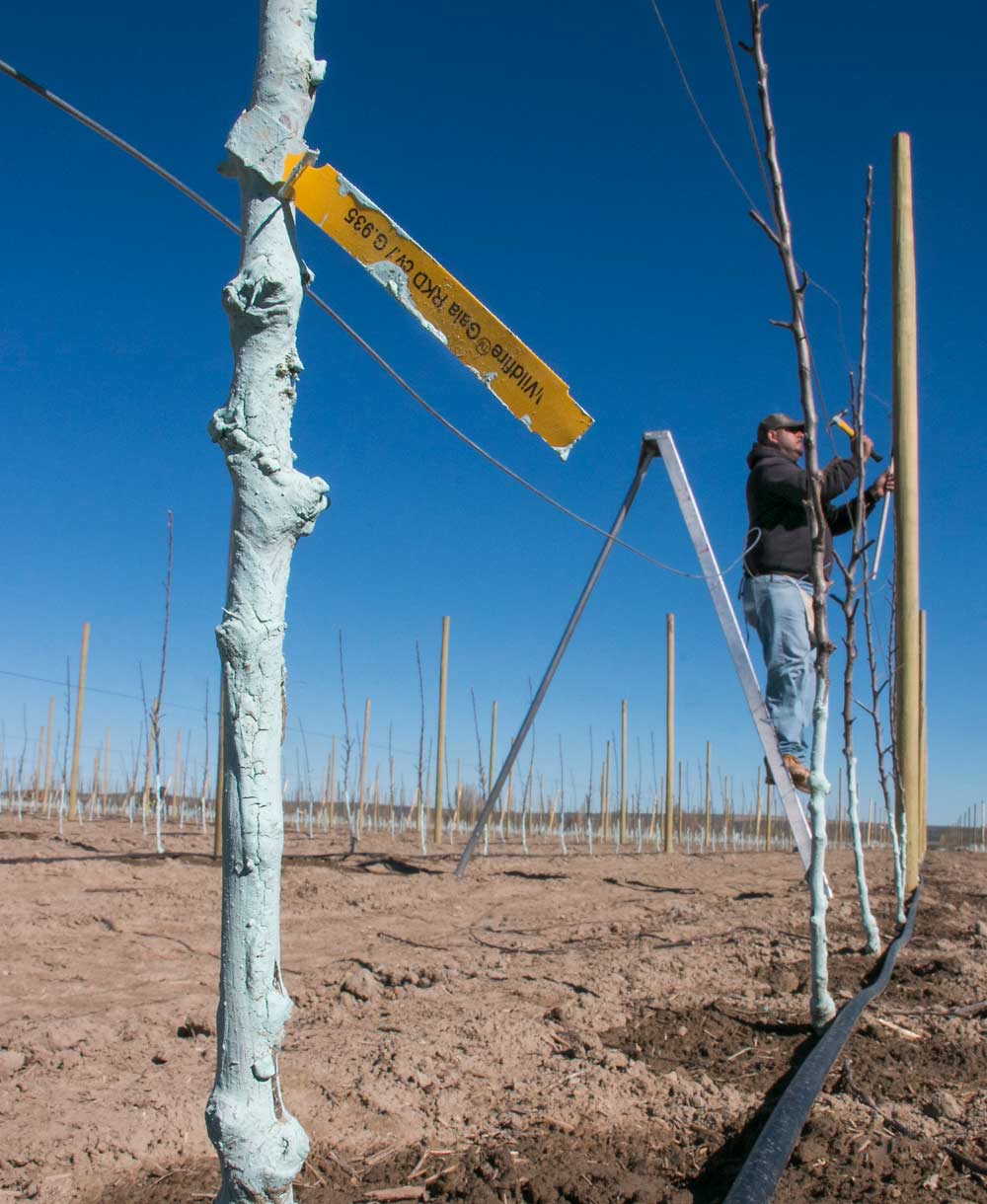
a worker uses plastic covered twist ties and string to train limbs of second-leaf Wildfire Galas in Royal City, Washington, in April. The cost of hand labor to train young trees, not to mention planting expenses, is one of the many factors growers must weigh when deciding whether to switch varieties. (Ross Courtney/Good Fruit Grower)
At tens of thousands of dollars per acre, starting a new fruit variety can be a daunting decision.
Not for Rich Callahan.
The Royal City, Washington, orchardist takes the simple view: “It’s easy. If I go to the warehouse and I’m not getting paid, it’s a real easy choice.”
Over the past several years, Callahan has replaced traditional varieties such as Fujis, standard Galas, Braeburns and Reds with hot-selling newcomers such as Honeycrisp and Wildfire Gala, an early ripening, Corvette-red strain he found as a chance mutation about 10 years ago.
He’s right, said other growers and some packers. Orchardists must figure out what’s selling when deciding which varieties to grow and when to switch.
But that’s not the only consideration.
“There’s so many factors that come into play,” said Steve Lutz, senior strategist for Columbia Marketing International of Wenatchee, Washington.
The laundry list of decision points includes the market for variety they might remove, their current variety mix, how the new variety fits in the marketing plan of their warehouses, the microclimate of their site and their financial ability to afford risk.
They also must realize that even high-demand apples have growing quirks. For example, the hot-selling club variety Ambrosia, the patent of which expires this month, has a very tight harvest window. “As we look at Ambrosia opening up, that’s what worries me,” Lutz said.
Columbia Marketing, or CMI, markets the Ambrosia apple for McDougall & Sons, a Wenatchee-based grower and packer.
Expensive decision
The decision can be an expensive one.
Growers typically estimate the cost of starting a new orchard at $15,000 to $30,000 per acre. Scott McDougall, president of McDougall & Sons, puts it more like $60,000, including two years of pre-production costs, labor housing expenses and property purchases.
“At 80 bins per acre, you better be thinking you’re going to return $300 per bin from the warehouse” with a new variety, McDougall said. Typically, well-grown Fujis, Galas and Granny Smiths fetch more like $200 per bin.
He also advised growers to make sure they can handle the variety they choose. Honeycrisp, known for high prices and low packouts, is a good example.
Then again, standing pat on a variety carries its own risks.
Growers need to look five, 10 years down the road when they make decisions, said Rick Derrey, a Zillah, Washington, small grower and manager of the ENZA apple variety program.
New varieties are coming out all the time and many more are in the pipeline, some that don’t even have names yet.
“Most of them eat and store better than anything we’re growing now,” he said.
Something has to make way for them, both in the orchards and on the store shelves. That means pushing up existing orchards. “Even when a block might still be profitable,” he said.
He suggests orchardists start talking to warehouses and sales desks right away about coming varieties and how to get involved. Many of them will be club varieties.
“Don’t wait until you are losing money”

A worker fastens trellis wire to a post in a new planting of Wildfire Galas. (Ross Courtney/Good Fruit Grower)
Likewise, Karen Lewis, Washington State University tree fruit regional extension specialist, suggested looking ahead.
“Don’t wait until you are losing money,” she said. “Evaluate your blocks … annually and set goals to replant blocks that are most likely not going to meet performance and return goals. Trees must be ordered in advance so again, track your numbers, read the market and plan years ahead. It is not if you will need to replant, it is when.”
Too few growers of any crop, both fruit and otherwise, are able to make an effective five-year plan, said Clark Seavert, an agricultural economist with Oregon State University in Corvallis.
If they don’t know now, all orchardists should learn how to calculate their cost of production compared to their income block by block, taking into account packouts, returns per box and cost of running equipment. Then, they need to look five years down the road and try to predict how the balance will tilt.
“If you see yourself losing money three, four years down, now’s the time,” he said.
Manson Growers, a packing house and sales office in Manson, Washington, encourages its growers to visit with their sales staff, said Doug England, general manager. Even then, nobody can predict the future, he said.
He recalls a time when warehouses touted varieties such as the Golden Supreme, Gingergold and El Star, then turned around and had to tell growers to pull them out when they didn’t sell as well as they thought.
“Most of our growers come in and say, ‘Tell me what to plant,’” he said. “I can make a guess for them but it will be a guess.”
He also advises his growers, most of them located near Lake Chelan, to keep their eyes open for niches.
For example, the microclimate of the hills in that area lends itself to Golden Delicious, and though the variety is hardly a cash cow, the warehouse sells to some of the same customers for 50 years who still want it.
Plant with labor in mind
Labor is another factor.
Other growers besides Callahan are planting the Wildfire Gala because it ripens about two weeks earlier than the more entrenched strains, allowing them to spread out their labor.
Morgan Rowe, a Naches, Washington, grower is planting Wildfires, as well as Honeycrisps, in place of older Bing cherry orchards that didn’t set a solid crop. Next year, he plans to replace a block of Reds with Cosmic Crisp. He doesn’t use H-2A labor and needs to spread out his resources.
“I’m not going to replant everything with Honeycrisp because I’ll never get them all picked,” he said.
Chip Bailey, a New York State grower, called planting varieties to stretch the season a good idea, as long as those varieties have a market. “If the consumer wants two apples and they harvest at the same time, then that’s my issue, it’s not the consumer’s,” he said.
Bailey, a licensed grower of the SweeTango club variety, advocated balance. He also has blocks of McIntosh, Red Delicious, Honeycrisp, Gala, Fuji, Jonagold and Cameo. He gradually switches to new varieties, targeting the next least profitable orchard each year.
That’s exactly what Callahan of Royal City lays on his chopping block. He is down to about 20 acres of Red Delicious this year and will cut that in half again by next year.
“I love what I do, but it’s a business,” he said. “And if you’re not willing to make the changes and look ahead a little bit and have some vision, you’re not going to be in the industry in 10 years.” •
– by Ross Courtney







Leave A Comment